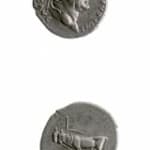Silver Denarius of Emperor Vespasian, 77 CE - 78 CE
Silver
C.3029
Obverse: Laureate Bust of Emperor Facing Right Surrounded by Text, 'IMP CAESAR VESPASIANVS AVG' Reverse: Pair of Oxen Under Yoke, Text Beneath, 'COS VIII' Vespasian was one of the most...
Obverse: Laureate Bust of Emperor Facing Right Surrounded by Text, "IMP CAESAR VESPASIANVS AVG"
Reverse: Pair of Oxen Under Yoke, Text Beneath, "COS VIII"
Vespasian was one of the most human of all the Roman emperors. He appreciated a good joke, even when he was the butt of it. Legend states that he never had an innocent man punished, and even wept for condemned criminals when it was necessary that they be executed. He was an old soldier, and would often show kindness to other old soldiers. He was well aware of the labors of the common man: his father was a tax collector, and Vespasian himself had to become a mule driver after he was banished from Nero's court for falling asleep during one of Nero's performances. Later, Nero made him a general and put him in command of an army sent to put down a revolt in Judea. When Vespasian became emperor his son Titus replaced him as general in Judea and finally put down the revolt in A.D. 70. Vespasian died on June 23, A.D. 79 after a short illness. As he was at the point of death, he struggled to stand up, saying that an emperor should die on his feet. He even made a joke about his own death. It was the custom to consecrate popular emperors after their deaths, declaring them a minor god. Vespasian was heard to say as he was about to expire, "Oh my, I fear I am about to become a god!"
How many hands have touched a coin in your pocket or purse? What eras and lands have the coin traversed on its journey into our possession? As we reach into our pockets to pull out some change, we rarely hesitate to think of who might have touched the coin before us, or where the coin will venture to after it leaves our hands. More than money, coins are a symbol of the state that struck them, of a specific time and location, whether active currencies in the age we live or artifacts of a long forgotten empire. This stunning hand-struck coin reveals an expertise of craftsmanship and intricate sculptural detail that is often lacking in contemporary machine-made currencies. Although history often leaves little room for the benevolent leaders that looked after the welfare of their citizens, opting instead to highlight those who started great wars or constructed great monuments often at the expense of the people, the memory of Vespasian will live on in artifacts like this coin: concrete remnants of ancient empires passed from the hands of civilization to civilization, from generation to generation.
Reverse: Pair of Oxen Under Yoke, Text Beneath, "COS VIII"
Vespasian was one of the most human of all the Roman emperors. He appreciated a good joke, even when he was the butt of it. Legend states that he never had an innocent man punished, and even wept for condemned criminals when it was necessary that they be executed. He was an old soldier, and would often show kindness to other old soldiers. He was well aware of the labors of the common man: his father was a tax collector, and Vespasian himself had to become a mule driver after he was banished from Nero's court for falling asleep during one of Nero's performances. Later, Nero made him a general and put him in command of an army sent to put down a revolt in Judea. When Vespasian became emperor his son Titus replaced him as general in Judea and finally put down the revolt in A.D. 70. Vespasian died on June 23, A.D. 79 after a short illness. As he was at the point of death, he struggled to stand up, saying that an emperor should die on his feet. He even made a joke about his own death. It was the custom to consecrate popular emperors after their deaths, declaring them a minor god. Vespasian was heard to say as he was about to expire, "Oh my, I fear I am about to become a god!"
How many hands have touched a coin in your pocket or purse? What eras and lands have the coin traversed on its journey into our possession? As we reach into our pockets to pull out some change, we rarely hesitate to think of who might have touched the coin before us, or where the coin will venture to after it leaves our hands. More than money, coins are a symbol of the state that struck them, of a specific time and location, whether active currencies in the age we live or artifacts of a long forgotten empire. This stunning hand-struck coin reveals an expertise of craftsmanship and intricate sculptural detail that is often lacking in contemporary machine-made currencies. Although history often leaves little room for the benevolent leaders that looked after the welfare of their citizens, opting instead to highlight those who started great wars or constructed great monuments often at the expense of the people, the memory of Vespasian will live on in artifacts like this coin: concrete remnants of ancient empires passed from the hands of civilization to civilization, from generation to generation.



